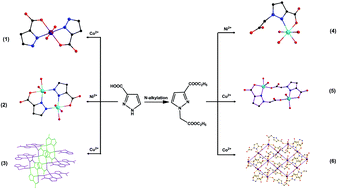Highly efficient electrochemiluminescence based on pyrazolecarboxylic metal organic framework†
Abstract
A series of transition metal complexes with the ligands 3-pyrazoledicarboxylic acid (H2L1) and ethyl 1-(2-ethoxy-2-oxoethyl)-1H-pyrazole-3-carboxylate (epzc) have been synthesized. The epzc generated 1-(carboxymethyl)-1H-pyrazole-3-carboxylic acid (H2L2) by an in situ hydrothermal hydrolysis reaction, using a one-pot method. Simple mononuclear [Co(HL1)2(H2O)2] (1) and [Ni(L2)(H2O)4] (4), dinuclear [Ni2(L1)2(H2O)6]·H2O (2) and [Cu2(L2)2(H2O)4] (5) and 2D frameworks [Cu2(L1)2]n (3), [Co2(L2)2(H2O)4]n (6) have been isolated. The structures have been established by single-crystal X-ray diffraction, and the complexes characterized by FT-IR, thermogravimetric analysis (TGA), PRXD, UV–Vis spectroscopy, and fluorescent spectroscopy. 1, 2, 4 and 5 were further assembled to form a supramolecular structure by hydrogen-bonding interactions and/or π⋯π stacking. 3 and 6 both possess a 2D network structure that is further interlinked via intermolecular hydrogen-bonding interactions. Most importantly, the complexes demonstrated highly intense electrochemiluminescence (ECL) in DMF solution.


 Please wait while we load your content...
Please wait while we load your content...